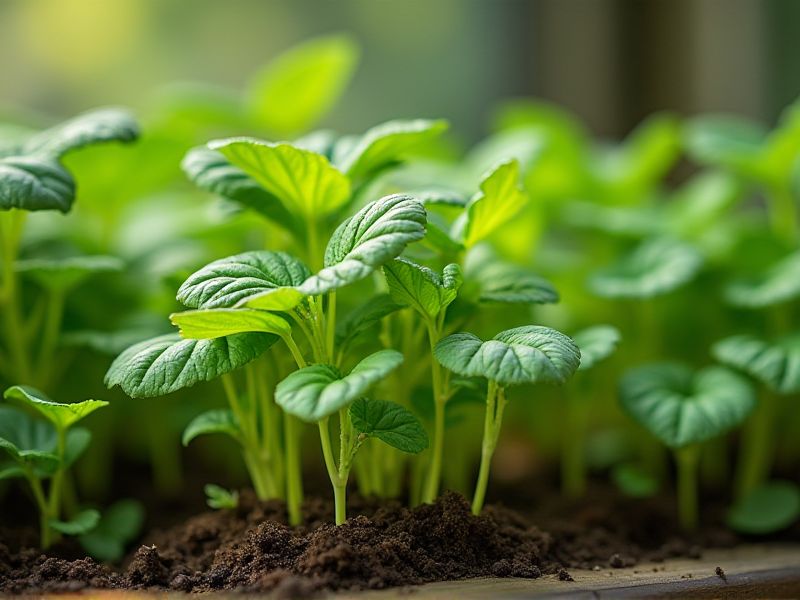
Herbs such as basil, mint, and parsley thrive indoors, making them ideal for small spaces. Utilizing container gardening techniques with well-draining soil enhances growth and flavor. Indoor vegetable varieties like cherry tomatoes and bell peppers can flourish under proper lighting conditions, typically needing 12-16 hours of light daily. Incorporating a hydroponic system can maximize space and resource efficiency while ensuring nutrient-rich produce. Regular watering and monitoring for pests are crucial for maintaining a healthy indoor garden, contributing to your culinary creations.
List of some Culinary plants that grow indoors
- Basil (Ocimum basilicum)
- Parsley (Petroselinum crispum)
- Mint (Mentha)
- Chives (Allium schoenoprasum)
- Thyme (Thymus vulgaris)
- Rosemary (Salvia rosmarinus)
- Sage (Salvia officinalis)
- Cilantro (Coriandrum sativum)
- Oregano (Origanum vulgare)
- Tarragon (Artemisia dracunculus)
Important things about Culinary plants that grow indoors
Light Requirements
Culinary plants that grow indoors thrive best under specific light conditions, making proper lighting essential for healthy growth. Herbs like basil, parsley, and cilantro flourish with 12-16 hours of bright, indirect light daily, often benefiting from full-spectrum LED grow lights. If you're growing plants in a window with limited sunlight, rotating them regularly can help ensure even exposure to available light. Consider using reflective materials around your indoor garden to maximize light absorption and promote robust growth in your culinary plants.
Soil Drainage
Proper soil drainage is crucial for cultivating culinary plants indoors, as it prevents root rot and promotes healthy growth. Choosing a well-draining potting mix, often composed of peat moss, perlite, and vermiculite, will enhance aeration and moisture control. You should also ensure containers have drainage holes to facilitate water escape, preventing waterlogged conditions. Monitoring moisture levels is essential, as indoor culinary plants like basil, cilantro, and chives thrive in well-managed irrigation environments.
Temperature Control
Maintaining optimal temperature control is essential for the successful growth of culinary plants indoors. Most herbs, such as basil and cilantro, thrive best in temperatures ranging from 65degF to 75degF, ensuring vigorous growth and potent flavor. Conversely, plants like rosemary prefer slightly cooler conditions, ideally around 60degF to 70degF, to prevent wilting and maintain their aromatic oils. You should monitor indoor temperatures regularly, especially during seasonal changes, to create a stable environment that fosters your indoor culinary garden's health and productivity.
Humidity Levels
Maintaining optimal humidity levels is crucial for the successful growth of culinary plants indoors, as many herbs and vegetables thrive in environments with humidity between 40% and 60%. Plants such as basil, cilantro, and mint particularly benefit from increased moisture in the air, as it enhances their flavor and growth rate. Using a humidifier or placing trays of water near your plants can help maintain these levels, especially in dry climates or during winter months. Regularly monitoring humidity with a hygrometer ensures your indoor garden remains vibrant and productive.
Watering Frequency
Culinary plants that grow indoors, such as basil, mint, and cilantro, require consistent watering to thrive. The soil should be kept moist but never waterlogged, as excessive moisture can lead to root rot. Check the top inch of the soil; if it feels dry, it's time to water. Adjust your watering frequency based on factors like plant size, pot material, and indoor humidity to ensure optimal growth and flavor in your herbs.
Fertilization Needs
Culinary plants that thrive indoors require specific fertilization methods to maximize growth and flavor. Organic fertilizers such as compost or worm castings can provide essential nutrients, supporting healthy root development and enhancing flavor profiles of herbs like basil, parsley, and cilantro. Regular fertilization schedules, typically every four to six weeks, are crucial for indoor plants, particularly in limited soil conditions. You can also monitor your plants for signs of nutrient deficiencies, adjusting your fertilization approach to ensure optimal indoor crop production.
Pest Management
Culinary plants grown indoors, such as basil, cilantro, and parsley, offer a delightful way to enhance your cooking with fresh flavors. To maintain healthy growth, be vigilant against common pests like aphids, spider mites, and whiteflies, which can thrive in indoor environments. Employing natural pest control methods, such as introducing beneficial insects like ladybugs or using insecticidal soap, can help protect your indoor garden without harmful chemicals. Regularly inspecting your plants and ensuring proper air circulation and moisture levels will further minimize pest problems while promoting vibrant growth.
Plant Selection
Culinary plants that thrive indoors include herbs like basil, cilantro, and parsley, which can enhance your cooking while adding fresh flavors to your dishes. This indoor gardening option allows you to grow non-GMO, organic produce year-round, boosting your culinary creations with homegrown freshness. To ensure successful growth, provide your plants with adequate sunlight, ideally south-facing windows, and maintain consistent moisture levels in the soil. Indoor gardening not only elevates your meals but also contributes to improved air quality and adds a vibrant touch to your home decor.
Harvesting Techniques
When cultivating culinary plants indoors, understanding proper harvesting techniques is essential for maximizing yield and flavor. For herbs like basil, snip the leaves just above a node to encourage bushier growth. Vegetables such as lettuce can be harvested by cutting the outer leaves while allowing the inner leaves to continue growing for future harvests. Ensuring your indoor environment has adequate light and humidity will promote healthy growth, making each harvest more rewarding.
Seasonal Growth Patterns
Indoor culinary plants exhibit distinct seasonal growth patterns that can enhance your cooking year-round. Herbs like basil and cilantro thrive in spring and summer, requiring ample sunlight and warmth to reach their peak flavors. In cooler months, you can cultivate hearty crops like chives and parsley, which prefer moderate temperatures and can even withstand slight frost. By strategically timing your plantings and adjusting indoor lighting, you can enjoy a continuous supply of fresh herbs and vegetables tailored to seasonal culinary needs.
